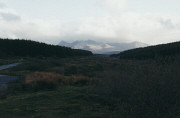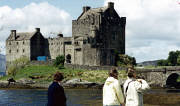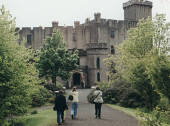Wednesday, May 24, 2000
Isle of Skye
There is something magic about three days. For me that is usually when I’m ready to head back home. But not this time. I had thought about home, but only as a basis of comparison to the different sort of life in Scotland.

The two hour drive to the Isle of Skye took us past memorable vistas of mountains, valleys, rivers, and everything in between. Even the sun peeked through the white billowing tufts overhead and put spots of brilliant green and yellow among the shadows of the clouds. The odd light made the rivers a most unusual blue that snaked along the valleys and disappeared in the dark green horizon.
Just before reaching the island on Highway A87, serendipity greeted us that morning with the discovery of Eilean Donan Castle near Dornie. The castle was not listed in any of our literature and we dove into the parking area for a look. The castle consumes almost all of Eilean Donan Island. The origin of the structure seems to be very controversial and many versions of it can be found in Scottish lore. It is one of the oldest castles and was destroyed in the 18th century and rebuilt by Lieutenant Colonel John MacRae-Gilstrap between 1912 and 1932.

The castle is unlike the others we had seen. The huge mass of stone seems to grow out of the island like large square stalagmites. Its fanciful fa�ade reflects a spirit of romance and intrigue. A tour of the completely restored interior piqued my curiosity and likenesses of some of the inhabitants depicted scenes that one may have witnessed had they lived there. The castle tour displayed a very clear idea of the self-sufficiency the building once enjoyed. We would have stayed longer, but we were anxious to move onto Skye.
Dunvegan Castle
Five pounds and seventy got us across Skye Bridge and into the town of Kyleakin on the east side. A quick lunch at a restaurant with a buffet that wasn’t so quick fueled us enough to head across the island for Dunvegan. The roadways were no different from those on the mainland. The almost entirely mountainous landscape left no room for straight-aways and flats. Towns were scarce and the traffic light. The road across the island hugged the hillsides like an undersized belt on a fat belly.
The Isle of Skye, an island off the northwest coast of Scotland, reflected a healthy attitude toward unpretentious living. We passed through many small towns before landing on the northwest shore of the island. While driving across the island there was no mistaking the area for anywhere but Scotland. Trees found no place to grow on the rustic mountains that instead sprouted rocks and heather and formed a barrier from the sea that let in only small rivulets to sustain its livelihood.
No matter where we went, we seemed to be followed by an ancestral presence, like we were being watched and protected. The sparse population left much of the land to sheep and pastures. Dunvegan, like most of the villages, was little more than a few houses and small businesses.

The castle surprised us all. It loomed over the shoreline like an historic sentry that had forgotten time. Except for the absence of the moat, The entrance sat heavily on the ground, a dark face of weathered stone undisturbed for centuries. The novelty I felt visiting other castles disappeared when I stood before the entrance to Dunvegan Castle. The huge austere fa�ade had blackened with smudges of time and it seemed to meld together the gray gravel underfoot and the dismal overcast sky. I felt cold as its dark and almost invisible doors stared back at me, unfriendly and uncaring, and hidden deep within the shadow of an arch that looked like a large mouth that would swallow any who dared to enter. The castle had its purpose and we were not intended as a part of it.
We slipped inside quietly as if avoiding any sudden noise that would arouse its wrath. The interior was not quite as bleak as its exterior but it would not be my choice for a comfortable abode. I carried with me the chill that had clutched me at the front and I tried to imagine what sort of people had lived there. The hard icy stone aside of me in the chasm of smallish rooms and more of it under foot unhidden by the carpet and the distant ceilings that had once been forests gave my stomach a slight tightness. The musty odor of ancient lives. The reverberation of the slightest, most insignificant sounds. It almost spawned a rush of adrenaline.
While following the paths worn into the floor and up and down the steps eroded by ages of feet treading on them, I felt a sense of permanence there. Like who ever inhabited this foreboding place would never leave. Ever. I suppose that would account for the ghost stories that cling to the existence of these monuments.
I was almost glad to leave Dunvegan Castle but yet I felt that many questions had just been asked and I would never be able to answer them. I could swear I felt a sudden rush of cold air behind me hastening our exit. I was sure I would see this place again. Probably in my dreams.
Skye Silver and Edinbane Pottery
The experience of Dunvegan Castle was long to wear off as we headed west of Dunvegan toward Skye Silver. Advertisements in brochures had promised a selection of unique jewelry with a Celtic theme. My driving skills were tested again as navigation in this part of the country proved to be more difficult. The miniature road markers almost escaped detection and after one pass by the turn to the shop, we doubled back and caught the single lane road that was protected by what we would call a cattle guard instead of a gate.
The roads that ambled through this habitat of one of Scotland’s largest industries were little more than paved trails. I consider secondary roads major thoroughfares by comparison. A particular breed of sheep wandered about freely with their long shaggy wool resembling four-legged mops. Oncoming traffic required frequent use of lay-bys for passing since the single lane roads barely accommodated the width of our car. The trick is in spotting one of these accessories to pop into before on oncoming vehicle meets you and there you sit bumper to bumper each waiting for the other to do something.
It was impossible to exceed the speed limit between the sheep that occupied the roadway although even the slow speed seemed like we were racing along a driveway. The only advantage I saw for my nerves was the fact that there was only one side of the road to worry about: the center. And the sheep were less concerned with our presence than I was about theirs.
I remember wondering if the sign we saw what seemed like ten miles earlier had actually read “Skye Silver 5 miles.” The austere white building stood alone atop a small knoll overlooking absolutely nothing except sheep and rock filled pasture. Now, I’m not one to taken in by jewelry, but something about the unusual Celtic influence in the gold and silver creations inspired the romantic fantasies that I imagine whenever Scotland is mentioned. I had seen nothing like them. Beneath glaring lights the small pieces glistened with an elegance rich in Scottish heritage and expert craftsmanship. And their small sizes appealed to our present situation, if you remember the coziness of the rental car.
During our brief visit the remote shop had attracted three other groups of shoppers, I suppose much like a trading post on a cattle trail. We were fortunate to find it by car because I didn’t believe there would be any other way to get there. I couldn’t envision a bus on the tiny road. At least not with all of its wheels on the pavement. We each purchased a favorite item within our budget as many were not, and routed the car back through the throng of sheep that seemed even less concerned than before.
Back over the cattle guard and heading east, we arrived at Edinbane, eight miles from Dunvegan. A sign led us down an off street to Edinbane Pottery. We were pleasantly surprised at the unique designs and rich earthy colors of the many types of pottery. The afternoon was wearing on and the shop was preparing to close so we finished browsing and left for Portree toward the opposite shore of the island.
Portree on the Isle of Skye
Portree is the largest city on the island and wraps around a calm and scenic bay off the Sound of Raasay. Our late arrival found nearly empty streets and ample parking in the business district populated by hotels and restaurants. After a short stroll while we window-shopped, we stopped into a restaurant on the ground floor of a hotel. The tile floor and sparse utilitarian chrome and plastic covered tables looked like something out of the fifties.
We were offered better accommodations in the restaurant upstairs and we were shown to a table in the center of a classic dark paneled British pub like room complete with bar and lively patrons. Our casual dress blended well with the locals but stood out dramatically from the colorful carpet and tartan accents. It was a while getting our food. My daughter was puzzled by her lasagna and it did look different from the lasagna I was used to seeing, but she was pleased with the flavor. My sister-in-law, also curious about her pork stew, also enjoyed its rich taste. It was only three bites into the meal when the waitress cautiously announced that due a mix-up in the kitchen, two of the dishes were switched. The lasagna was
actually lamb hot pie and the pork stew was really lamb stew. We refused the offer to replace them since everyone was content with their meal.
Another five pounds and seventy saw us off of the Isle of Skye and we settled in for the three hour drive back to Aviemore. Since daylight lingers into the night, it was more like driving in the late afternoon. Although traffic was not heavy, the constant swerve of the roads and glare even from the hidden sunlight took its toll on my endurance. It was almost midnight before we parked in front our unit at the lodge.